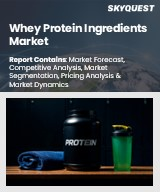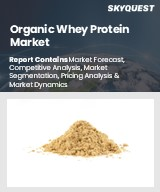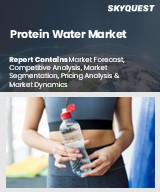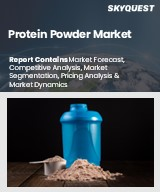
|
시장보고서
상품코드
1822460
세계의 유청 단백질 시장 예측(-2032년) : 제품별, 형태별, 유통 채널별, 용도별, 지역별 분석Whey Protein Market Forecasts to 2032 - Global Analysis By Product (Whey Protein Concentrate, Whey Protein Isolate, Whey Protein Hydrolysate, Native Whey Protein and Other Products), Form, Distribution Channel, Application and By Geography |
||||||
Stratistics MRC에 의하면, 유청 단백질 세계 시장은 2025년에 141억 3,000만 달러, 2032년에는 266억 8,000만 달러에 이를 것으로 예측되며, 예측 기간 중 연평균 복합 성장률(CAGR)은 9.5%로 전망됩니다. 유청 단백질은 치즈 제조 과정에서 발생하는 액체 부산물인 유청에서 추출한 고품질 단백질입니다. 필수 아미노산 9종을 모두 함유하여 근육 성장, 회복 및 전반적인 건강을 지원하는 완전 단백질입니다. 유청 단백질은 체내에서 빠르게 흡수되어 운동선수, 보디빌더, 피트니스 애호가들 사이에서 인기가 높습니다. 농축물, 분리물, 가수분해물 등 다양한 형태로 제공되며, 각각 단백질 함량과 가공 방식이 다릅니다. 근육 지원 외에도 유청 단백질은 균형 잡힌 식단에 포함될 경우 체중 관리에 도움을 주고, 면역력을 향상시키며, 포만감을 촉진할 수 있습니다.
인도 청소년부(Ministry of Youth Affairs and Sports)에 따르면, 정부는 Fit India Movement와 같은 피트니스 이니셔티브를 적극적으로 추진하고 있으며, 매일 30-60분의 적당한 신체 활동을 권장하는 연령별 프로토콜을 통해 피트니스 문화를 제도화하고 있다고 합니다.
건강과 피트니스에 대한 인식이 높아짐
소비자들은 운동 능력, 면역력, 신진대사 건강을 지원하기 위해 단백질 보충제를 일상 생활에 도입하고 있습니다. 스포츠 영양, 기능성 식품, 개인 맞춤형 웰니스 플랫폼과의 통합으로 그 범위가 확대되고 있습니다. 일반인 대상 캠페인과 피트니스 인플루언서들이 체육관, 소매점, 이커머스 채널에서 채택을 강화하고 있습니다. 수요는 운동선수, 피트니스 애호가, 건강 지향적인 소비자에게까지 확대되고 있습니다. 이러한 역학은 건강과 피트니스에 대한 인식이 유청 단백질 시장의 주요 촉진요인으로 작용하여 전체 시장의 성장을 가속하고 있습니다.
높은 제조 및 가공 비용
비용 효율적인 원자재와 첨단 가공 기술에 대한 접근성이 제한적이라는 점이 수익성에 영향을 미치고 있습니다. 규제 준수와 품질 보증이 경영상의 오버헤드를 더욱 증가시키고 있습니다. 소비자의 가격 민감도가 신흥 시장에서의 채택을 지연시키고 있습니다. R&D 집약도와 인프라 요구사항이 기술 혁신을 억제하고 있습니다. 이러한 요인들은 단백질이 풍부한 제품에 대한 수요 증가에도 불구하고 시장 확대를 억제하고 있습니다.
유명인의 추천과 미디어의 영향력
피트니스계의 아이콘과 건강 전문가들의 추천이 구매 행동과 브랜드 충성도를 형성하고 있습니다. 디지털 플랫폼, 소셜 미디어, 컨텐츠 마케팅과의 통합은 인지도와 전환율을 높이고 있습니다. 브랜드 구축과 소비자 교육에 대한 공공 및 민간의 투자는 점점 더 활발해지고 있습니다. 기호도가 높고, 라이프스타일에 맞는 영양에 대한 수요가 연령대와 지역을 초월하여 확대되고 있습니다. 이러한 발전은 시장 성장에 유리한 조건을 제공하고 유청 단백질 제품의 채택을 가속화하고 있습니다.
유당불내증과 식이 제한
제조업체는 진화하는 영양 요구를 충족시키기 위해 제형상의 문제를 극복하고 제품을 다양화해야 합니다. 완두콩, 콩, 쌀 등의 대체 단백질이 대체 식품으로 인기를 끌고 있습니다. 규제와 라벨링 요구 사항으로 인해 제품 포지셔닝이 복잡해지고 있습니다. 클린 라벨과 알레르겐이 없는 제품을 찾는 소비자 수요가 시장 역학을 재편하고 있습니다. 이러한 제약은 경쟁 압력을 가져와 본격적인 시장 발전을 제약하고 있습니다.
코로나19의 영향
코로나19 팬데믹은 유청단백질 시장을 혼란에 빠뜨렸고, 일시적인 공급망 중단, 체육관 활동 감소, 소비자 지출의 변화를 일으켰습니다. 소매점 폐쇄와 물류의 어려움은 제품 수급과 유통에 영향을 미쳤습니다. 그러나 면역력, 홈트레이닝, 셀프 케어에 대한 관심이 높아지면서 경기 둔화를 부분적으로 상쇄했습니다. 팬데믹 이후 회복세는 전자상거래, 개인 맞춤형 처방, 임상용 단백질 용도의 혁신과 함께 전 세계 시장에서 접근성, 고품질, 기술 기반 영양 솔루션에 대한 수요가 증가하고 있는 데 따른 것입니다.
유청 단백질 농축물(WPC) 부문은 예측 기간 동안 최대 규모에 이를 것으로 예측됩니다.
유청 단백질 농축물(WPC) 부문은 균형 잡힌 단백질 함량, 저렴한 가격, 다양한 용도로 인해 예측 기간 동안 가장 큰 시장 점유율을 차지할 것으로 예측됩니다. WPC는 소화성과 아미노산 프로파일로 인해 스포츠 영양, 기능성 식품, 건강 보조 식품에 널리 사용되고 있습니다. 제조업체는 맛, 용해도, 보존 안정성을 위해 배합을 최적화하고 있습니다. 피트니스 센터, 소매점, 온라인 플랫폼 수요는 여전히 강세를 보이고 있습니다. 규제 당국의 지원과 소비자의 친근감이 채택을 촉진하고 있습니다.
예측 기간 동안 임상 및 의료 영양 부문은 가장 높은 CAGR을 보일 것으로 예측됩니다.
예측 기간 동안 임상 및 의료 영양 부문은 회복기, 노인 케어, 만성 질환 관리에서 치료용 단백질에 대한 수요에 힘입어 가장 높은 성장률을 보일 것으로 예측됩니다. 유청단백질은 경장영양제, 수술 후 식사, 면역지원제제에 포함되어 있습니다. 병원, 진료소, 장기요양시설에서는 환자 결과를 위해 단백질 강화 제품의 사용이 확대되고 있습니다. 공중 보건에 대한 노력과 보험 적용이 채택을 촉진하고 있습니다. 고순도 및 생체 이용률이 높은 단백질에 대한 수요가 의료용 제제의 기술 혁신을 가속화하고 있습니다.
가장 큰 점유율을 차지하는 지역
예측 기간 동안 북미는 선진화된 낙농 인프라, 높은 소비자 인식, 강력한 소매 생태계로 인해 가장 큰 시장 점유율을 차지할 것으로 예측됩니다. 미국과 캐나다는 제품 혁신, 임상 연구, 스포츠 영양의 채택을 선도하고 있습니다. 예방적 건강, 피트니스, 건강보조식품에 대한 공공의 노력이 수요를 강화하고 있습니다. 지역 제조업체와 세계 브랜드는 옴니채널 전략과 개인화된 제품 제공을 확대하고 있습니다. 규제가 명확해지고 미디어의 인지도가 높아지면서 보급이 촉진되고 있습니다.
CAGR이 가장 높은 지역
예측 기간 동안 아시아태평양은 건강에 대한 인식 증가, 중산층 인구 증가, 영양 프로그램에 대한 정부 투자로 인해 가장 높은 CAGR을 보일 것으로 예측됩니다. 중국, 인도, 일본, 한국 등의 국가들은 생산, 유통, 소비자에 대한 단백질 보충 교육을 확대하고 있습니다. 민관 파트너십과 모바일 퍼스트 전략을 통해 도시 및 반도시 지역에서의 접근성이 개선되고 있습니다. 합리적인 가격과 문화에 맞는 기능성 영양 제품에 대한 수요가 기술 혁신을 촉진하고 있습니다. 지역 제조업체와 세계 기업이 협력하여 솔루션의 지역화 및 확장을 위해 노력하고 있습니다.
무료 커스터마이징 서비스
본 보고서를 구독하는 고객은 다음과 같은 무료 맞춤화 옵션 중 하나를 이용할 수 있습니다.
- 기업 소개
- 추가 시장 기업의 종합적인 프로파일링(최대 3개사까지)
- 주요 기업의 SWOT 분석(3개사까지)
- 지역 세분화
- 고객의 관심에 따른 주요 국가별 시장 추정, 예측, CAGR(주: 타당성 확인에 따라 다름)
- 경쟁사 벤치마킹
- 제품 포트폴리오, 지리적 입지, 전략적 제휴를 기반으로 한 주요 기업 벤치마킹
목차
제1장 주요 요약
제2장 서문
- 개요
- 이해관계자
- 조사 범위
- 조사 방법
- 데이터 마이닝
- 데이터 분석
- 데이터 검증
- 조사 접근
- 조사 자료
- 1차 조사 자료
- 2차 조사 정보원
- 전제조건
제3장 시장 동향 분석
- 성장 촉진요인
- 성장 억제요인
- 기회
- 위협
- 제품 분석
- 용도 분석
- 신흥 시장
- COVID-19의 영향
제4장 Porter의 Five Forces 분석
- 공급 기업의 교섭력
- 바이어의 교섭력
- 대체품의 위협
- 신규 진출업체의 위협
- 경쟁 기업간 경쟁 관계
제5장 세계의 유청 단백질 시장 : 제품별
- Whey Protein Concentrate (WPC)
- Whey Protein Isolate (WPI)
- Whey Protein Hydrolysate (WPH)
- 기타
제6장 세계의 유청 단백질 시장 : 형태별
- 분말
- Ready-to-Drink (RTD)
- 바 및 스낵
제7장 세계의 유청 단백질 시장 : 유통 채널별
- 슈퍼마켓 및 하이퍼마켓
- 전문점
- 온라인 소매
- 약국 및 드럭스토어
제8장 세계의 유청 단백질 시장 : 용도별
- 스포츠 영양학
- 강화 식품 및 음료
- 유아용 조제분유 및 이유식
- 임상 및 의료 영양
- 체중 관리
- 퍼스널케어 및 화장품
- 동물 영양 및 반려동물 사료
- 뉴트라슈티컬
- 기타
제9장 세계의 유청 단백질 시장 : 지역별
- 북미
- 미국
- 캐나다
- 멕시코
- 유럽
- 독일
- 영국
- 이탈리아
- 프랑스
- 스페인
- 기타 유럽
- 아시아태평양
- 일본
- 중국
- 인도
- 호주
- 뉴질랜드
- 한국
- 기타 아시아태평양
- 남미
- 아르헨티나
- 브라질
- 칠레
- 기타 남미
- 중동 및 아프리카
- 사우디아라비아
- 아랍에미리트(UAE)
- 카타르
- 남아프리카공화국
- 기타 중동 및 아프리카
제10장 주요 발전
- 계약, 파트너십, 협업 및 합작투자(JV)
- 인수와 합병
- 신제품 발매
- 사업 확대
- 기타 주요 전략
제11장 기업 프로파일링
- Glanbia PLC
- Arla Foods amba
- Fonterra Co-operative Group Limited
- Lactalis Group
- FrieslandCampina N.V.
- Hilmar Cheese Company, Inc.
- Saputo Inc.
- Agropur Cooperative
- Kerry Group plc
- Leprino Foods Company
- Davisco Foods International, Inc.
- Carbery Group
- Milk Specialties Global
- Alpavit
- AMCO Proteins
According to Stratistics MRC, the Global Whey Protein Market is accounted for $14.13 billion in 2025 and is expected to reach $26.68 billion by 2032 growing at a CAGR of 9.5% during the forecast period. Whey protein is a high-quality protein derived from whey, the liquid by-product of cheese production. It contains all nine essential amino acids, making it a complete protein that supports muscle growth, repair, and overall health. Whey protein is rapidly absorbed by the body, which makes it popular among athletes, bodybuilders, and fitness enthusiasts. It is available in various forms, including concentrates, isolates, and hydrolysates, each differing in protein content and processing. Beyond muscle support, whey protein may aid weight management, improve immunity, and promote satiety when incorporated into a balanced diet.
According to the Ministry of Youth Affairs and Sports, the government has been actively promoting fitness initiatives, such as the Fit India Movement, which institutionalizes fitness culture through age-appropriate protocols recommending 30-60 minutes of moderate-to-vigorous physical activity daily.
Market Dynamics:
Driver:
Rising health and fitness awareness
Consumers are integrating protein supplements into daily routines to support athletic performance, immunity, and metabolic health. Integration with sports nutrition, functional foods, and personalized wellness platforms is expanding reach. Public campaigns and fitness influencers are reinforcing adoption across gyms, retail, and e-commerce channels. Demand spans across athletes, fitness enthusiasts, and health-conscious consumers. These dynamics are positioning health and fitness awareness as a key driver of the whey protein market, thereby boosting overall market growth.
Restraint:
High production and processing costs
Limited access to cost-efficient raw materials and advanced processing technologies is affecting profitability. Regulatory compliance and quality assurance further increase operational overhead. Price sensitivity among consumers is slowing adoption in emerging markets. R&D intensity and infrastructure requirements are tempering innovation. These factors are constraining market expansion despite rising demand for protein-rich products.
Opportunity:
Celebrity endorsements and media influence
Endorsements from fitness icons and health experts are shaping purchasing behavior and brand loyalty. Integration with digital platforms, social media, and content marketing is enhancing visibility and conversion. Public and private investments in brand-building and consumer education are reinforcing momentum. Demand for aspirational, lifestyle-aligned nutrition is expanding across age groups and regions. These developments are creating favorable conditions for market growth, thereby accelerating adoption of whey protein products.
Threat:
Lactose intolerance and dietary restrictions
Manufacturers must navigate formulation challenges and diversify offerings to meet evolving nutritional needs. Alternative proteins such as pea, soy, and rice are gaining traction as substitutes. Regulatory scrutiny and labeling requirements are increasing complexity in product positioning. Consumer demand for clean-label, allergen-free options is reshaping market dynamics. These limitations are introducing competitive pressure and constraining full-scale market development.
Covid-19 Impact:
The Covid-19 pandemic disrupted the Whey Protein market, causing temporary supply chain interruptions, reduced gym activity, and shifts in consumer spending. Retail closures and logistics challenges affected product availability and distribution. However, the increased focus on immunity, home workouts, and self-care partially offset the slowdown. Post-pandemic recovery is driven by growing demand for accessible, high-quality, and tech-enabled nutrition solutions, along with innovations in e-commerce, personalized formulations, and clinical-grade protein applications across global markets.
The whey protein concentrate (WPC) segment is expected to be the largest during the forecast period
The whey protein concentrate (WPC) segment is expected to account for the largest market share during the forecast period owing to its balanced protein content, affordability, and versatility across applications. WPC is widely used in sports nutrition, functional foods, and dietary supplements due to its digestibility and amino acid profile. Manufacturers are optimizing formulations for taste, solubility, and shelf stability. Demand remains strong across fitness centres, retail outlets, and online platforms. Regulatory support and consumer familiarity are reinforcing adoption.
The clinical & medical nutrition segment is expected to have the highest CAGR during the forecast period
Over the forecast period, the clinical & medical nutrition segment is predicted to witness the highest growth rate driven by demand for therapeutic-grade protein in recovery, elderly care, and chronic disease management. Whey protein is being integrated into enteral nutrition, post-surgical diets, and immune-support formulations. Hospitals, clinics, and long-term care facilities are expanding use of protein-enriched products for patient outcomes. Public health initiatives and insurance coverage are reinforcing adoption. Demand for high-purity, bioavailable protein is accelerating innovation in medical-grade formulations.
Region with largest share:
During the forecast period, the North America region is expected to hold the largest market share due to its advanced dairy infrastructure, high consumer awareness, and strong retail ecosystem. The U.S. and Canada are leading in product innovation, clinical research, and sports nutrition adoption. Public initiatives in preventive health, fitness, and dietary supplementation are reinforcing demand. Regional manufacturers and global brands are scaling omnichannel strategies and personalized offerings. Regulatory clarity and media visibility are supporting widespread deployment.
Region with highest CAGR:
Over the forecast period, the Asia Pacific region is anticipated to exhibit the highest CAGR driven by rising health consciousness, expanding middle-class population, and government investment in nutrition programs. Countries like China, India, Japan, and South Korea are scaling production, distribution, and consumer education around protein supplementation. Public-private partnerships and mobile-first strategies are improving access in urban and semi-urban areas. Demand for affordable, culturally adaptive, and functional nutrition products is reinforcing innovation. Regional manufacturers and global players are collaborating to localize and scale solutions.
Key players in the market
Some of the key players in Whey Protein Market include Glanbia PLC, Arla Foods amba, Fonterra Co-operative Group Limited, Lactalis Group, FrieslandCampina N.V., Hilmar Cheese Company, Inc., Saputo Inc., Agropur Cooperative, Kerry Group plc, Leprino Foods Company, Davisco Foods International, Inc., Carbery Group, Milk Specialties Global, Alpavit and AMCO Proteins.
Key Developments:
In April 2024, Arla Foods Ingredients partnered with Tetra Pak to optimize whey protein processing using energy-efficient filtration and heat exchange systems. This collaboration supports sustainable production and enhances the nutritional integrity of Arla's functional whey protein isolates.
In November 2023, Glanbia Performance Nutrition (GPN) partnered with Amazon and Walmart to expand digital shelf space for its whey-based brands, including Optimum Nutrition. These partnerships enhance global visibility and support omnichannel growth for Gold Standard Whey and related performance nutrition products.
Products Covered:
- Whey Protein Concentrate (WPC)
- Whey Protein Isolate (WPI)
- Whey Protein Hydrolysate (WPH)
- Native Whey Protein
- Other Products
Forms Covered:
- Powder
- Ready-to-Drink (RTD)
- Bars & Snacks
- Protein-enriched Bakery & Dairy Products
Distribution Channels Covered:
- Supermarkets & Hypermarkets
- Specialty Stores
- Online Retail
- Pharmacies & Drug Stores
Applications Covered:
- Sports Nutrition
- Fortified Food & Beverages
- Infant Formula & Baby Food
- Clinical & Medical Nutrition
- Weight Management
- Personal Care & Cosmetics
- Animal Nutrition & Pet Food
- Nutraceutical Companies
- Other Applications
Regions Covered:
- North America
- US
- Canada
- Mexico
- Europe
- Germany
- UK
- Italy
- France
- Spain
- Rest of Europe
- Asia Pacific
- Japan
- China
- India
- Australia
- New Zealand
- South Korea
- Rest of Asia Pacific
- South America
- Argentina
- Brazil
- Chile
- Rest of South America
- Middle East & Africa
- Saudi Arabia
- UAE
- Qatar
- South Africa
- Rest of Middle East & Africa
What our report offers:
- Market share assessments for the regional and country-level segments
- Strategic recommendations for the new entrants
- Covers Market data for the years 2024, 2025, 2026, 2028, and 2032
- Market Trends (Drivers, Constraints, Opportunities, Threats, Challenges, Investment Opportunities, and recommendations)
- Strategic recommendations in key business segments based on the market estimations
- Competitive landscaping mapping the key common trends
- Company profiling with detailed strategies, financials, and recent developments
- Supply chain trends mapping the latest technological advancements
Free Customization Offerings:
All the customers of this report will be entitled to receive one of the following free customization options:
- Company Profiling
- Comprehensive profiling of additional market players (up to 3)
- SWOT Analysis of key players (up to 3)
- Regional Segmentation
- Market estimations, Forecasts and CAGR of any prominent country as per the client's interest (Note: Depends on feasibility check)
- Competitive Benchmarking
- Benchmarking of key players based on product portfolio, geographical presence, and strategic alliances
Table of Contents
1 Executive Summary
2 Preface
- 2.1 Abstract
- 2.2 Stake Holders
- 2.3 Research Scope
- 2.4 Research Methodology
- 2.4.1 Data Mining
- 2.4.2 Data Analysis
- 2.4.3 Data Validation
- 2.4.4 Research Approach
- 2.5 Research Sources
- 2.5.1 Primary Research Sources
- 2.5.2 Secondary Research Sources
- 2.5.3 Assumptions
3 Market Trend Analysis
- 3.1 Introduction
- 3.2 Drivers
- 3.3 Restraints
- 3.4 Opportunities
- 3.5 Threats
- 3.6 Product Analysis
- 3.7 Application Analysis
- 3.8 Emerging Markets
- 3.9 Impact of Covid-19
4 Porters Five Force Analysis
- 4.1 Bargaining power of suppliers
- 4.2 Bargaining power of buyers
- 4.3 Threat of substitutes
- 4.4 Threat of new entrants
- 4.5 Competitive rivalry
5 Global Whey Protein Market, By Product
- 5.1 Introduction
- 5.2 Whey Protein Concentrate (WPC)
- 5.3 Whey Protein Isolate (WPI)
- 5.4 Whey Protein Hydrolysate (WPH)
- 5.5 Native Whey Protein
- 5.6 Other Products
6 Global Whey Protein Market, By Form
- 6.1 Introduction
- 6.2 Powder
- 6.3 Ready-to-Drink (RTD)
- 6.4 Bars & Snacks
7 Global Whey Protein Market, By Distribution Channel
- 7.1 Introduction
- 7.2 Supermarkets & Hypermarkets
- 7.3 Specialty Stores
- 7.4 Online Retail
- 7.5 Pharmacies & Drug Stores
8 Global Whey Protein Market, By Application
- 8.1 Introduction
- 8.2 Sports Nutrition
- 8.3 Fortified Food & Beverages
- 8.4 Infant Formula & Baby Food
- 8.5 Clinical & Medical Nutrition
- 8.6 Weight Management
- 8.7 Personal Care & Cosmetics
- 8.8 Animal Nutrition & Pet Food
- 8.9 Nutraceutical Companies
- 8.10 Other Applications
9 Global Whey Protein Market, By Geography
- 9.1 Introduction
- 9.2 North America
- 9.2.1 US
- 9.2.2 Canada
- 9.2.3 Mexico
- 9.3 Europe
- 9.3.1 Germany
- 9.3.2 UK
- 9.3.3 Italy
- 9.3.4 France
- 9.3.5 Spain
- 9.3.6 Rest of Europe
- 9.4 Asia Pacific
- 9.4.1 Japan
- 9.4.2 China
- 9.4.3 India
- 9.4.4 Australia
- 9.4.5 New Zealand
- 9.4.6 South Korea
- 9.4.7 Rest of Asia Pacific
- 9.5 South America
- 9.5.1 Argentina
- 9.5.2 Brazil
- 9.5.3 Chile
- 9.5.4 Rest of South America
- 9.6 Middle East & Africa
- 9.6.1 Saudi Arabia
- 9.6.2 UAE
- 9.6.3 Qatar
- 9.6.4 South Africa
- 9.6.5 Rest of Middle East & Africa
10 Key Developments
- 10.1 Agreements, Partnerships, Collaborations and Joint Ventures
- 10.2 Acquisitions & Mergers
- 10.3 New Product Launch
- 10.4 Expansions
- 10.5 Other Key Strategies
11 Company Profiling
- 11.1 Glanbia PLC
- 11.2 Arla Foods amba
- 11.3 Fonterra Co-operative Group Limited
- 11.4 Lactalis Group
- 11.5 FrieslandCampina N.V.
- 11.6 Hilmar Cheese Company, Inc.
- 11.7 Saputo Inc.
- 11.8 Agropur Cooperative
- 11.9 Kerry Group plc
- 11.10 Leprino Foods Company
- 11.11 Davisco Foods International, Inc.
- 11.12 Carbery Group
- 11.13 Milk Specialties Global
- 11.14 Alpavit
- 11.15 AMCO Proteins



















